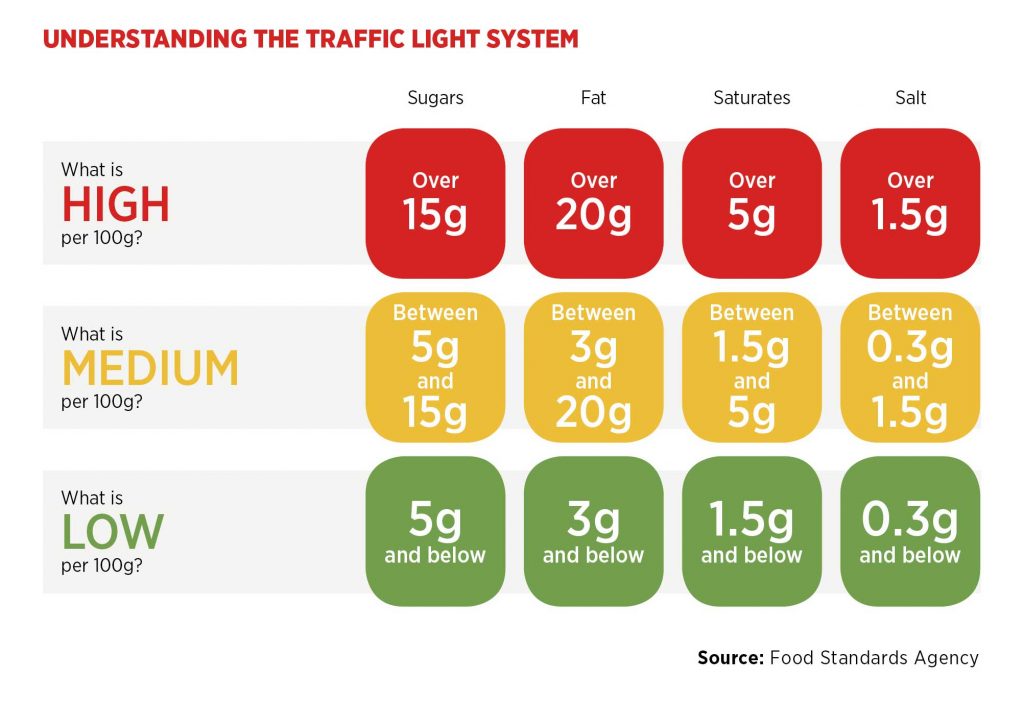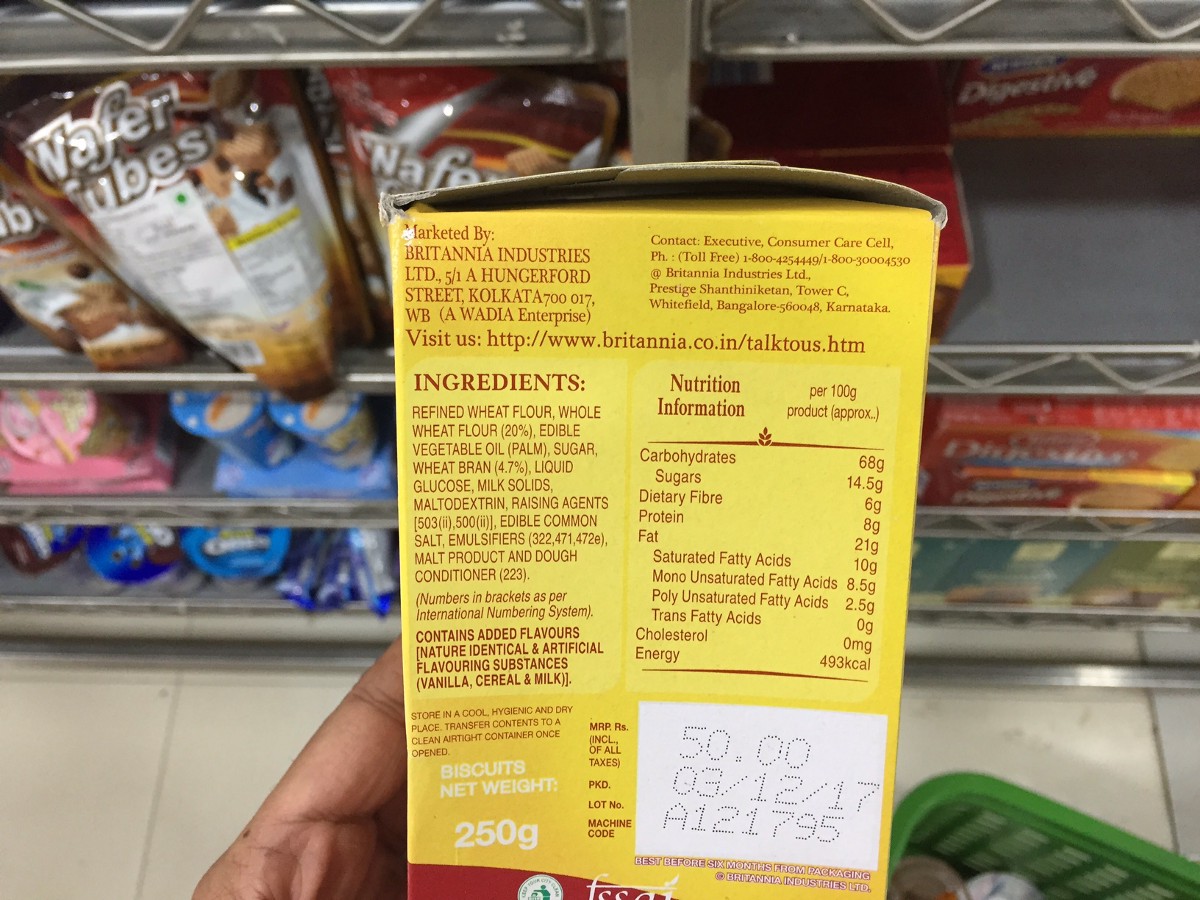44 how to read uk nutrition labels
This Is How to Read a Nutrition Facts Label on the Keto Diet Some labels show both, but it's simpler to assess using the percentage figure. You may also hear about RDI (Reference Daily Intake) and DRV (Daily Reference Values), which essentially mean the same thing as Percent Daily Value [ * ]. Ingredients List The ingredient list is usually found below or next to the nutrient breakdown. Food labelling - get into the habit of checking the label Look for five key points on the label: 1. Energy The terms 'kJ' and 'kcal' (calories) tell you how much energy is in a product. Women need an average of 2,000 kcal a day and men need 2,500 kcal on average. 2. Saturates Saturates is another word for saturated fat. This section tells you about the amount of saturated fat in the product. 3. Salt
Understanding Food Labels Made Easy - Weight Loss Resources How to Read Food Labels The Traffic Light Scheme Provides a colour code for four main nutrients we should eat less of - fat, saturates, sugars and salt - based on traffic light colours. The colours are worked out by looking at the nutrient content per 100g of the food: green indicates a low content, amber a medium content and red a high content.

How to read uk nutrition labels
How to Read Nutrition Labels for Low-Glycemic Shopping Women should consume 400 to 500 calories per meal. Men should consume 500 to 700 calories per meal. If your entree is less than the top number in the recommended calorie range, that's okay. Total fat: One of the three sources of calories for the body. Consuming a moderate amount of fats is important for your overall health. How to Read Food Labels | Institute of Health Sciences Some front-of-pack nutrition labels use red, amber and green colour-coding. Colour-coded nutritional information, as shown in the image above, tells you at a glance if the food has high, medium or low amounts of fat, saturated fat, sugars and salt. Red means high Amber means medium Green means low Food labels - NHS Some front-of-pack nutrition labels use red, amber and green colour coding. Colour-coded nutritional information tells you at a glance if the food has high, medium or low amounts of fat, saturated fat, sugars and salt: red means high amber means medium green means low In short, the more green on the label, the healthier the choice.
How to read uk nutrition labels. Food guidelines and food labels - NHS Guidelines and advice about food and food labels, including the Eatwell Guide. Food labels. Water, drinks and your health. The Eatwell Guide. Red meat and the risk of bowel cancer. How to Read a Nutrition Facts Label | The Beachbody Blog On the Nutrition Facts label, Total Carbohydrates includes dietary fiber, sugar, complex carbohydrates, and non-digestible additives. If you look below Total Carbohydrates, you'll see Dietary Fiber and Sugars are broken out. If you're looking for net carbs, just subtract the fiber from the Total Carbohydrates. Learning To Read Labels :: Diabetes Education Online On a nutrition food label, subtract the fiber from the total carbohydrate amount. When you read food labels, the grams of sugar are already included in the total carbohydrate amount, so you do not need to count this sugar amount separately. The grams of sugar listed include both natural sugars, from fruit or milk, and added sugars. Nutrition labelling | Food Standards Agency Nutrition information must be expressed per 100 g/ml, using the measurement units specified in Regulation 1169/2011 vitamins and minerals must be expressed per 100g/ml and as a percentage of the...
How to Understand and Use the Nutrition Facts Label | FDA When looking at the Nutrition Facts label, first take a look at the number of servings in the package (servings per container) and the serving size. Serving sizes are standardized to make it easier... How to Read Food Labels Without Being Tricked - Healthline Nutrition labels state how many calories and nutrients are in a standard amount of the product — often a suggested single serving. However, these serving sizes are frequently much smaller than what... Differences between EU and US nutrition labels go far beyond ounces and ... In the US, nutritional labels must indicate the number of servings per container - so calories are broken down based on how many slices of bread come in a package, or how many 12-chip portions a... How to read food labels - CNM College of Naturopathic Medicine You can determine the amount of sugar in a product by looking at "sugars" underneath the carbohydrates section in the nutritional panel. Every 4 grams of sugar equates to 1 teaspoon of (table) sugar. So, for example, if a product has 16g of sugar per serving, it actually contains 4 teaspoons of sugar.
How to read food product labels & packaging - Women's Fitness How to read food product labels. Note: while it's important to be aware of what you're putting into your body, becoming obsessive over reading food product labels can lead to dangerous eating habits. Chat to a healthcare provider if you're concerned about your relationship with food. Related: How to count macros for healthy weight management Understanding food labels | Diabetes UK The labels show how many calories are in the food or drink and are also colour coded to show whether the food is low (green), medium (amber) or high (red) in fat, saturated fat, sugar and salt. The information on the front of the pack also tells you how the portion of the food contributes to the Reference Intake (RI) of an adult. Nutrition labels - Food A Fact Of Life Arrange the pupils in a circle, gently throw the bean bag or ball to the first pupil who should answer a question. If they answer correctly, they should stay in the circle. If not, they should throw the bean bag or ball to another pupil and then sit down out of the circle. The game would then continue. Nutrient and Calorie Rounding Table | How To Read Nutrition Labels Shown below are the guidelines used to round off calorie and nutrient amounts: Nutrient. Increment Rounding. Insignificant Amount. Calories. Calories from Fat. Calories from Saturated Fat. < 5 cal - express as 0. ≤50 cal - express to nearest 5 cal increment.
How to Read a Nutrition Label | Kellogg's Toward the bottom of each label you'll find the percentage of vitamins and minerals that accompany every serving, with a higher percentage indicating that there is more of a vitamin or mineral in that food. These vitamins and minerals serve many functions in your body. And to help keep it working properly, you need a variety of these nutrients.
How to read food labels, food labeling, Organic Wholesale Club, organic foods, wholesale organic ...
Reading Nutrition Labels - Cronometer Serving sizes measured in grams, including a 100g serving size option Vitamin C, Vitamin A, Calcium, Iron %DV (based on 2000 kcal diet) This percentage is listed as the % of the RNI which is different than that of American targets. We will always report the numeric value (not the percent) in CRDB foods. Carbohydrates reported do NOT include fibre.
How to Read Nutrition Information → Food Labels EXPLAINED Learn how to read nutrition information on another level! Food labels EXPLAINED.Get our Fit Mother 30-Day Fat Loss Program here → ...
How To Read Food and Beverage Labels - National Institute on Aging At the top of the Nutrition Facts label, you will find the total number of servings in the container and the food or beverage's serving size. The serving size on the label is based on the amount of food that people may typically eat at one time and is not a recommendation of how much to eat. Read more about serving and portion sizes.
How To Read Nutrition Labels - Mayo Clinic Diet 3. Check the % Daily Value. The % Daily Value (DV) tells you how much a nutrient in a serving of food contributes to a daily diet. 2,000 calories a day is used for general nutrition advice. Low is 5% or less. Aim for low in saturated fat, trans fat, cholesterol, sodium, and added sugars. High is 20% or more. Aim high in vitamins, minerals and ...
How to understand Nutrition food labels (EU/UK) — Gemma Sampson Salt (sodium) Salt free - less than 0.01g salt per 100g (0.005g sodium) Low salt - less than 0.3g salt per 100g (0.01g sodium) High salt - more than 1.5g salt per 100g (0.6g sodium)
Check the label | Food Standards Agency The traffic light label is colour coded and shows that green is low in a particular nutrient, amber means medium and red is high in a nutrient. Red. means the product is high in a nutrient and you should try to cut down, eat less often or eat smaller amounts. Amber. means medium. If a food contains mostly amber, you can eat it most of the time.
How To Read Nutrition Labels (Like a Pro) - Ditch The Carbs Firstly you need to understand the difference between total and net carbs. TOTAL CARBS = sugars + starches +fibre NET CARBS = total carbs - fibre Carbohydrates will be on the nutrition label are often broken down into carbohydrates, sugars, starch, and fiber. However, each brand may display its nutritional contents differently.
Reading labels | Diabetes UK Always look at the 'total carbohydrate' on the label when carb counting. This will make sure you are counting both the complex (starchy) and simple (sugary) carbs in your food. Both will raise your blood glucose (blood sugar) levels, and need to be matched with insulin.
Understanding Food Nutrition Labels | American Heart Association Remember that the information shown in the label is based on a diet of 2,000 calories a day. You may need less or more than 2,000 calories depending upon your age, gender, activity level, and whether you're trying to lose, gain or maintain your weight. When the Nutrition Facts label says a food contains "0 g" of trans fat, but includes ...
Looking at labels - British Nutrition Foundation The majority of pre-packed products (by law) provide a nutrition label on the back of pack. This back-of-pack information must be displayed as per 100g or 100ml of the product, but may also be additionally displayed as per portion. Generally, this information will be displayed like the example below:
Food labels - NHS Some front-of-pack nutrition labels use red, amber and green colour coding. Colour-coded nutritional information tells you at a glance if the food has high, medium or low amounts of fat, saturated fat, sugars and salt: red means high amber means medium green means low In short, the more green on the label, the healthier the choice.
How to Read Food Labels | Institute of Health Sciences Some front-of-pack nutrition labels use red, amber and green colour-coding. Colour-coded nutritional information, as shown in the image above, tells you at a glance if the food has high, medium or low amounts of fat, saturated fat, sugars and salt. Red means high Amber means medium Green means low
How to Read Nutrition Labels for Low-Glycemic Shopping Women should consume 400 to 500 calories per meal. Men should consume 500 to 700 calories per meal. If your entree is less than the top number in the recommended calorie range, that's okay. Total fat: One of the three sources of calories for the body. Consuming a moderate amount of fats is important for your overall health.














Post a Comment for "44 how to read uk nutrition labels"